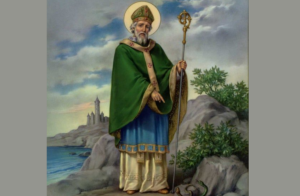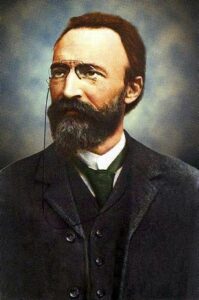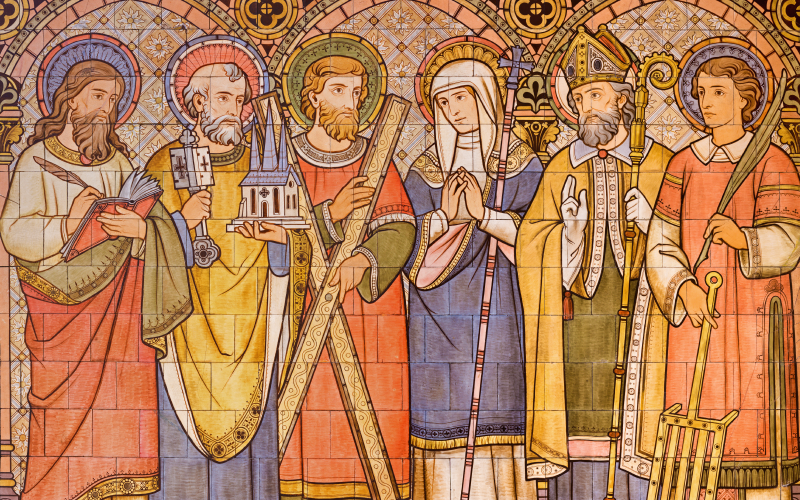The Power of Conversion as Seen in the Lives of the Saints
As a reminder, a canonized saint is a person who the Church declares to already possess the Beatific Vision (i.e., someone whose soul is in Heaven) and whose life is worthy of imitation on account of the virtues they possessed. See “Why Do Catholics Pray to Saints” for more information.
St. Francis of Assisi, St. Patrick, Blessed Bartolo Longo, St. Olga, St. Christopher, and countless other saints lived in different eras, in different trying circumstances, and in different states of life. But what unites all these saints is the power of conversion working in their lives. Not all saints grew up in holy families and persevered in God’s grace from their Baptism. In fact, many of the saints in Heaven show us the truth of Our Lord’s words: “I say to you, that even so there shall be joy in Heaven upon one sinner that doth penance, more than upon ninety-nine just who need not penance.” (Luke 15:7)
St. Francis of Assisi

Francis Bernardone was born in 1181 in Assisi, Umbria, Italy. His father, a wealthy cloth merchant, and his mother, Pica, had several other children, though history does not record the names and number of Francis’ siblings. At his baptism, St. Francis received the name Giovanni (John), but his father changed it to Francesco (Francis) in honor of France, where his business ventures fared promisingly. Francis became a favorite amongst the elite in Assisi and lived the life of a nobleman delighting in worldly possessions and entertainment.
At the age of 20, after living a life distant from God, Francis went to war against Perugia. He was captured and imprisoned for a year. While confined, he suffered a fever which apparently turned his thoughts to the things of eternity. However, he still desired a military career. The very night before his departure, he experienced a vision of Christ that changed his life.
When he was approached by his noble friends afterward, his demeanor was utterly changed. He was a man of the spirit. They asked him if he was to be married. Francis said, “Yes”, and he wanted to take as his bride ‘Lady Poverty’. He gave up his attire and sinful ways and submitted himself to a life of prayer and solitude. Although he was still uncertain over his change in life, he knew there would be no going back on his conversion.
As we know, Saint Francis went on to be the first saint ecclesiastically acknowledged to receive the stigmata[1] and found the Franciscan Order, for the glory of the Church and for the good of innumerable souls.
St. Patrick

St. Patrick was born in 387 A.D. in Scotland;[2] and at the age of 16, he was kidnapped and sent as a slave in Ireland. Saint Patrick was not profoundly religious as a child. But in Ireland, when he was put to solitary work as a shepherd, he began to pray. After six years of service and fervent prayer, St. Patrick received a heavenly dream where he was commanded to return to Britain. Saint Patrick escaped Ireland and returned to his homeland. In Britain, he converted to the Catholic Faith.
St. Patrick was ordained a priest by Saint Germanus in 432 and subsequently consecrated a bishop. Obeying another heavenly dream, he returned to Ireland to convert this pagan people to Christianity. Pope Saint Celestine sent him to evangelize England, then Ireland. Saint Patrick’s chariot driver was Saint Odran, and Saint Jarlath was one of his students. He advocated against slavery, idolatry, sun worship, occult practices similar to today’s ‘new age’ (druidism), and paganism. Shortly after his death, slavery was abolished in Ireland!
Some reports claim he built between 300-600 churches and countless schools and hospitals. In his 33 years in Ireland, he converted nearly the entire country. Because of his work, Ireland became known as the Land of Saints. Saint Patrick died around 461 A.D. in Ireland, where he worked for years to evangelize.
Blessed Bartolo Longo

One example of the power of Our Lady in bringing about conversions through the Rosary is seen in Blessed Bartolo Longo, who was originally a satanic priest before converting and becoming a Third Order Dominican! He was a “High Priest” of the Satanists before his conversion no less! But he died a saint, and a Knight of the Holy Sepulcher.
Bartolo Longo was born in Naples, Italy in 1841. Like all his contemporaries, he was baptized as an infant. In his adolescence, he drifted so far away from God and his religious upbringing that he eventually became a satanic priest. When satanic forces were tormenting him, his family – who had never stopped praying for him – convinced him to make a good confession. He did so and was helped by a priest who encouraged him to become devoted to the Holy Rosary. In 1870, he became a Third Order Dominican and chose to live a life of penance in reparation for all the sins he committed as a satanic priest. One day, nearly falling headlong to despair for all the sins he had committed, he was inspired to remember Mary’s promise that She would help all those who encouraged others to pray the Rosary.
Blessed Longo began a mission to promote the Rosary and to restore the ruined chapel of Pompeii. Many conversions and miraculous cures took place there as people became devoted to the Rosary and pledged to build a new shrine in honor of Our Lady of the Rosary. At the same time, Pope Leo XIII (1878-1903) was promoting the Rosary throughout the world, and he strongly encouraged Bartolo in his pious work. Pope Leo XIII is frequently called the “Pope of the Rosary” as he wrote more than sixteen encyclicals and apostolic letters regarding the Rosary, Our Lady’s Psalter.
Blessed Longo wrote of his personal struggles with mental illness, paranoia, depression, and anxiety. At one point, he noted struggling with suicidal thoughts, but rejected them by continuing to recall the promise of the Blessed Virgin Mary to Saint Dominic that “he who propagates My Rosary will be saved.” Longo wrote that this promise is what convinced him to encourage public devotion to the Rosary. He credits the Rosary with his continual conversion.
Conclusion
It is never too late for someone to convert and change his life. Inversely, there is no assurance that a person will persevere in sanctifying grace and attain Heaven. Each day we must work to better live the Gospel message so that, by God’s grace, when our time to leave this world comes, we die in the state of sanctifying grace. This is all that matters. While the degree of glory the souls possess in Heaven will vary depending on their merits in this life, everyone who does make it to Heaven will possess the greatest of all graces – the vision and presence of God for all eternity.
Never give up praying and working for the conversion of your friends and family.
ENDNOTES:
[1] There is a school of thought that St. Paul received the stigmata, evidenced by him writing: “I bear on my body the marks of Jesus” (Gal. 6:17). However, the Church has been silent on this issue of St. Paul as the first stigmatist.
[2] Some say that St. Patrick was born in England or Britain; but according to https://www.newadvent.org/cathen/11554a.htm, he was born at Kilpatrick in Scotland.




